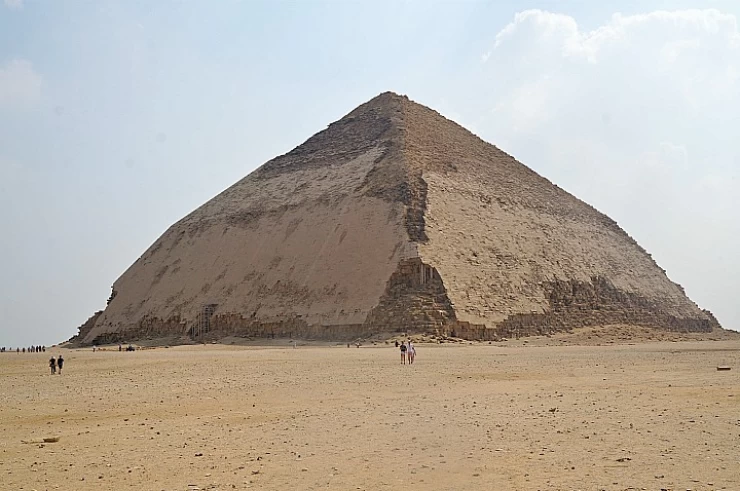
The Ninth Dynasty of Ancient Egypt History
The Ninth Dynasty of Ancient Egypt History
The 9th dynasty is from Heracleopolis, with 19 kings and a duration, according to Manetho, of 409 and 185 years. For all this time, the name of only one king, Actos, placed in the ninth dynasty, is mentioned. Manetho says he was crueler than all his predecessors, but then he ended up mad and torn to pieces by a crocodile.
We are completely unaware of the circumstances that led to the rise of the "House of Akhtoy.". The city of origin, Heracleopolis, is today's Ihnasya el-Medina, a town west of the Nile opposite Beni Sueif, 55 miles south of Memphis. Nothing has remained to reveal the importance it had in antiquity, but testimonies found elsewhere confirm what Manetho has handed down to us on the Heracleopolitan origin of the IX and X dynasties.
We understand that the name of Actos, or Akhtoy, was chosen by no less than three different rulers for their second cartouche. It is very probable, even if certain documents are lacking, that the first king of the dynasty adopted the name of Horo as Meribtowe ("Beloved in the heart of the Two Countries"), and to give more strength to his claims, he did not hesitate to assume all pharaonic titles.
To have risen to this very high rank, he must have had a character of exceptional energy, but all that remains to validate the authenticity of his existence is a copper brazier from the Louvre, an ebony stick from Mir, and a few other objects equally meaningless. A second Akhtoy, whose first name was Wahkara, is known only through a finely decorated coffin from El-Bersha, on which it seems that his cartouches were written by mistake in place of those of the true owner, the Intendant Nefri.
The existence of a third king of the same name, Akhtoy Nebkaura, is attested only by a weight coming from the excavations in Er-Retaba and by a citation in one of the few works of Egyptian fiction that have come down to us, in which the story of a farmer in the peripheral oasis of Wadi Natrun, robbed of his donkey and all the merchandise on his way to Heracleopolis.
The Emergence of the Ninth Dynasty
Amidst this chaos, a new dynasty emerged in Heracleopolis (an important city in Lower Egypt), and the Ninth Dynasty was part of a regional struggle for power that had itself become a dominant force in Lower Egypt, especially in the Nile Delta. The rulers of the Ninth Dynasty made endeavors to maintain and expand their power through these fractured political times, often competing with other regional leaders, particularly the Thebans of Upper Egypt, who later would be part of the Tenth Dynasty.
The Pharaohs of the Ninth Dynasty
The rulers of the Ninth Dynasty were relatively short-lived, much like the dynasties surrounding them. Since scanty records for this period are to be found, little information is returned regarding the specific deeds attributed to them. It is said that the Ninth Dynasty spanned approximately 2160-2130 BCE and comprised no fewer than eight known rulers. These rulers usually took a back seat compared to the rather more famous Theban kings of the Eleventh Dynasty, who succeeded in reuniting Egypt afterwards. Following the collapse of the Old Kingdom, he would have had to deal with consolidating the rule of Lower Egypt. His rule was largely unstable because, like many of his successors, he could not restore the glory days of the Old Kingdom.
Neferkare: Another ruler of the Ninth Dynasty, Neferkare is said to have been in power at a time when Heracleopolis was in a constant struggle against Thebes further south for supremacy.
Ikauhor: Little is known about Ikauhor's reign, which placed him among the later rulers of the Ninth Dynasty. It may have been a period marked by internal upheaval, particularly in view of Thebes' growing prominence in Upper Egypt.
Bebi I and Bebi II: These two rulers belong to a family line connected with the Ninth Dynasty. It is believed that they ruled toward the end of this period, when the Heracleopolitan pharaohs were likely becoming less powerful in the face of the more powerful Theban rulers.
The Eighth Old Egyptian Dynasty: A Fragmentation-and-Changes Period
The history of ancient Egypt is an overwhelming mixture of grandeur, mystery, and influence that lasts until today. Of all the dynasties excised from the long story of the Egyptian civilization, the Eighth is the least known and somewhat elusive. As part of the Old Kingdom era, the Eighth Dynasty receives little fame, overshadowed by the grander dynasties in the historical annals of Egypt, such as the Fourth with the Great Pyramids of Giza or the Sixth with its inevitable end. Yet, a hitherto lesser-known dynasty, established somewhat between roughly 2181 and 2160 BCE, contributed significantly to Egypt's stained but transforming political landscape.
Context: Decline of the Old Kingdom
To this end, when attempting to translate the meaning of the Eighth Dynasty, it becomes necessary to situate it more broadly with respect to the Old Kingdom. It is generally during this Age of the Pyramids when Egypt reached unparalleled heights of prosperity and centralized power. Towards the end of the Sixth Dynasty (ca. 2181 BCE), however, Egypt faced a time of internal strife, political fragmentation, and weakening authority.
The centralized control of the pharaohs began to deteriorate, as provincial governors—known as nomarchs—gained increasing power over their regions. In the first place, this period is referred to as the First Intermediate Period, as the once-unified kingdom breaks down and regional rulers emerge as competitors.
The increasing chaos marked the Eighth Dynasty—a time when Egypt was about to plunge into a political crisis. Most of the rulers of this dynasty were relatively short-lived, and their reigns were defined by instability. Egypt had splintered into numerous small territories ruled by separate local authorities, with the central authority of the pharaoh often only symbolic rather than practical.
Latest Articles
Admin
Seabourn Sojourn Cruise Stops in Safaga Port
The Seabourn Sojourn, the flagship vessel of Seabourn Cruise Line's ultra-luxury fleet, was built in 2008 at the T. Mariotti shipyard in Genoa, Italy. Measuring 198 metres, it can accommodate up to 450 guests in its 225 spacious all-suite staterooms.
Admin
Norwegian Sky Cruise Stops in Safaga Port
Norwegian Cruise Line operates a cruise ship called the Norwegian Sky. It was constructed in 1999 and can accommodate 2,004 passengers in addition to 878 crew members. The ship has several dining establishments, lounges and bars, a spa and fitness center, swimming pools, and a number of entertainment areas.
Admin
Explora II Cruise Stops in Safaga Port
Explora II, the second vessel in the Explora Journeys fleet, sets sail in 2024 to redefine luxury cruising. With 461 ocean-front suites, 9 culinary experiences, and 4 pools, this haven of sophistication and sustainability promises an unforgettable "Ocean State of Mind" journey to inspiring destinations.
Admin
Mein Schiff 6 Cruise Stops in Safaga Port
The Mein Schiff 6 is the latest cruise ship in the renowned TUI Cruises fleet, offering passengers a luxurious and sophisticated cruise experience. At 315 metres long, this floating resort features a range of dining options, entertainment, and recreational facilities, including a spa, fitness centre, and sports amenities.
Admin
Mein Schiff 4 Cruise Stops in Safaga Port
When the Mein Schiff 4 cruise ship docks in Safaga, Egypt, passengers are granted access to a realm of ancient wonders. Aboard this state-of-the-art vessel, guests can embark on meticulously curated shore excursions that showcase the region's most iconic landmarks, including the Giza Pyramids, the enigmatic Sphinx, and the remarkable tombs and temples of the Valley of the Kings in Luxor.
Admin
MS Europa Cruise Stops in Safaga Port
The Silver Moon, Silversea's latest flagship, is a luxury cruise ship that offers an exceptional travel experience for Venezuelans exploring Egypt. With a capacity of 596 guests and an impressive 40,700 gross tonnes, the Silver Moon maintains the small-ship intimacy and spacious all-suite accommodations that are the hallmarks of the Silversea brand.









-webp.webp)







